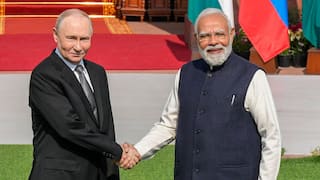India, China Pull Back Troops From Patrolling Point 15 In Eastern Ladakh
Even as the troops disengage from the crucial face-off site at PP-15, there has not been any progress on the resolution of the standoff in Demchok and Depsang regions

New Delhi: Indian and Chinese troops on Monday completed the troop disengagement at the Patrolling Point 15 (PP-15) in the Gogra-Hotsprings area in eastern Ladakh and dismantled temporary infrastructure in the region as part of a five-day disengagement process. Even as the troops disengage from the crucial face-off site at PP-15, there has not been any progress on the resolution of the standoff in Demchok and Depsang regions.
The troops from both sides disengaged as per the plan which also entailed a joint verification of the entire process, as per the source, reported news agency PTI. "The full details of the disengagement and the verification process are being awaited from the ground commanders," added the source.
What’s the status of the disengagement process?
On September 8, both countries announced that they have kicked off the disengagement process from the PP-15, which is seen as a significant move in the stalled process of pull-out troops from the remaining friction points in the region.
Army Chief Gen Manoj Pande said: "I will have to go and take stock. But, it (disengagement process) is going as per schedule, and what was decided". All the temporary infrastructure erected at the face-off site has been dismantled, according to the sources. However, it is not clear if the two sides will create a "buffer zone" at PP-15 as it was done after the troops disengaged in friction points on the north and south banks of the Pangong lake and at Patrolling Point 17(A) last year. Also, note that troops don’t undertake patrolling in the buffer zone.
The disengagement in the Gogra-Hotsprings area comes after the 16th round of high-level military talks in July.
The ministry of external affairs had earlier informed that the disengagement process in this area started on September 8 at 830 hours and will be completed by September 12. “The two sides have agreed to cease forward deployments in this area in a phased, coordinated and verified manner, resulting in the return of the troops of both sides to their respective areas," external affairs ministry spokesperson Arindam Bagchi said on September 9 that the disengagement process in PP-15 will be completed by Monday.
"It has been agreed that all temporary structures and other allied infrastructure created in the area by both sides will be dismantled and mutually verified. The landforms in the area will be restored to the pre-stand-off period by both sides," Bagchi added.
Under the agreement, the Line of Actual Control (LAC) in this area will be strictly observed and respected by both sides, and that there will be no unilateral change in the status quo, noted Bagchi.
"With the resolution of the stand-off at PP-15, both sides mutually agreed to take the talks forward and resolve the remaining issues along LAC and restore peace and tranquillity in India-China border areas," he said.
Initially, around 30 soldiers from each side were embroiled in a face-off in PP-15, but the number of troops kept changing depending on the overall situation in the region.
The disengagement in the Pangong Lake area happened in February last year while the withdrawal of troops and equipment in Patrolling Point 17 (A) in Gogra took place in August last year. The eastern Ladakh border standoff erupted on May 5, 2020, following a violent clash in the Pangong lake areas.






































